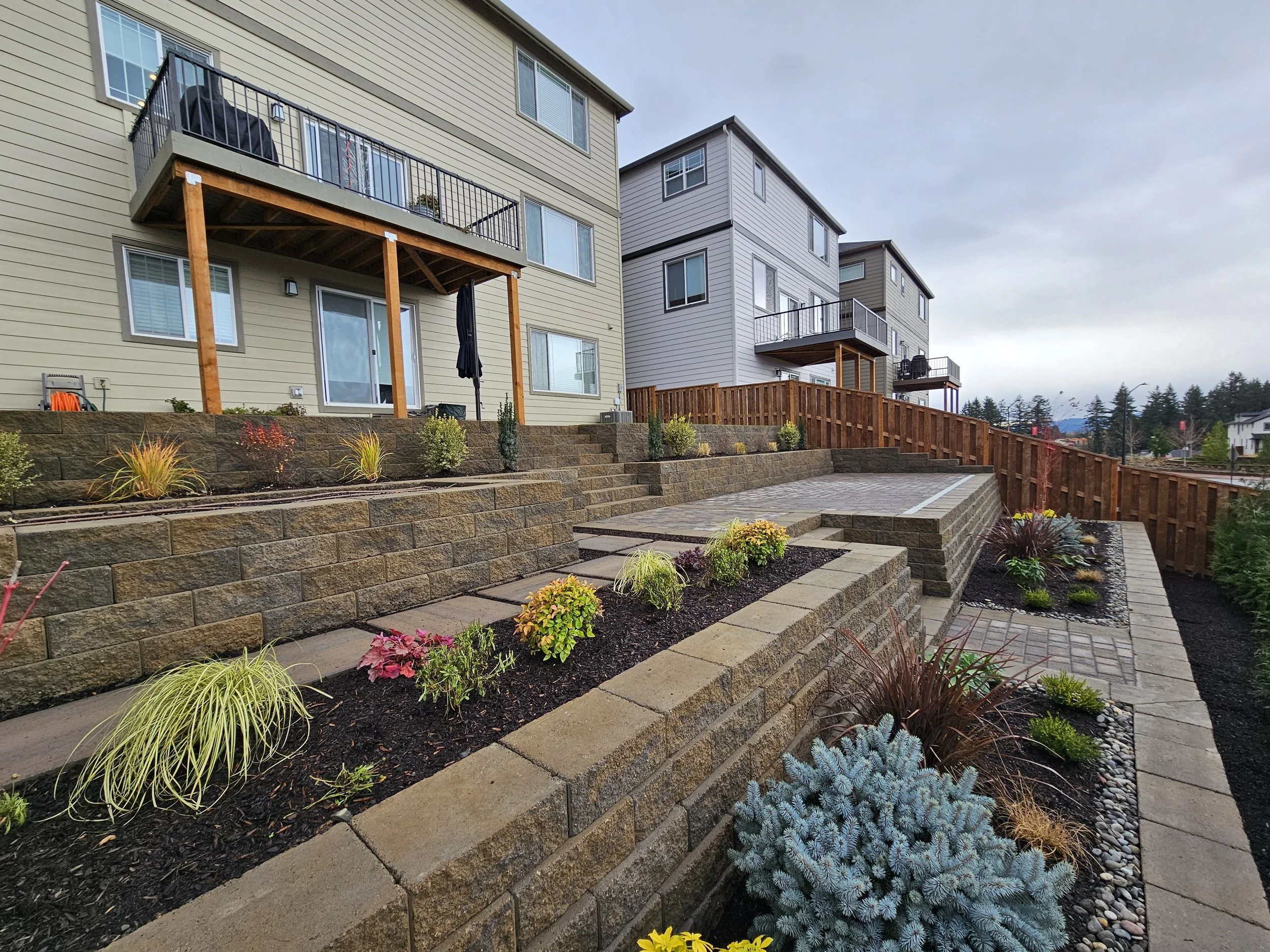Hillside Headaches? How to Turn Slopes into Spaces You’ll Love
You're not alone if your backyard looks more like a ski slope than a family hangout. Here in the Portland metro, it’s common to find homes built on hillsides or lots with uneven grades. While the views are often incredible, the reality is less glamorous: erosion, water runoff, mowing nightmares, and wasted space.
The good news? With the right design and landscape construction, those steep slopes can be transformed into layered outdoor spaces that add beauty, value, and function to your property. Let’s explore how to turn hillside headaches into hillside havens.
Why Hillsides Are Tricky
A steep yard can feel intimidating. Homeowners often struggle with:
Erosion & Drainage Issues – Rain races down the slope, washing away soil, mulch, and sometimes even plants.
Safety Concerns – Slippery slopes aren’t ideal for kids, pets, or outdoor entertaining.
Unusable Space – It’s hard to set up a dining area or garden when the ground is anything but level.
Maintenance Hassles – Try mowing a steep incline in the Oregon rain. It’s a workout nobody enjoys.
Left untreated, slopes are inconvenient and can damage retaining walls, compromise foundations, and turn landscaping into a constant repair project.
The Case for Terracing
One of the most effective ways to tame a slope is by cutting it into flat, usable tiers. Think of terraces as outdoor “steps,” each one a potential room in your landscape.
Terracing can create:
Upper patios with views – Perfect for seating areas, fire pits, or dining tables.
Middle garden beds – Planters, shrubs, and small trees thrive on leveled soil.
Lower play zones – Turf or synthetic grass for kids and pets to run around.
Terraces not only make the space functional but also control erosion and direct water safely away from the home.
Retaining Walls That Work Hard (and Look Good)
Retaining walls aren’t just about holding back soil, they’re design opportunities. With the right materials, they add structure and personality to your yard.
Popular options in Portland backyards include:
Natural stone boulders – Rustic and organic, they blend beautifully with the Pacific Northwest landscape.
Paver blocks – Sleek, uniform, and versatile for modern builds.
Timber or concrete – Great for budget-conscious solutions or bold architectural statements.
Adding features like built-in seating, steps, or lighting can turn a retaining wall from a purely functional necessity into a centerpiece of your outdoor living space.
Water Management: The Hidden Hero
Any hillside project in Oregon has to factor in water. If you don’t, winter rains will undo all your hard work. Smart drainage is what separates a successful hillside transformation from a constant headache.
Solutions might include:
French drains to move water through layers of gravel and pipe.
Dry creek beds that double as decorative features.
Strategic grading to direct water away from foundations and walkways.
A well-designed system means no more muddy puddles or washed-out soil whenever the clouds open up.
Adding Function and Fun
Once the slope is stabilized, the fun begins. Some ideas Portland homeowners love:
Multi-level patios – One for dining, one for lounging.
Garden tiers – Grow veggies, herbs, or ornamental plants in easy-to-access beds.
Synthetic turf terraces – No mowing, no mud, just soft play zones.
Fire pit landings – A cozy spot with built-in seat walls, framed by hillside views.
Pathways and stairs – Connect the levels with stone steps, gravel paths, or winding walkways.
Instead of a yard you avoid, you’ll end up with outdoor rooms that feel like an extension of your home.
How Summit Landscape Helps
At Summit Landscape, we’ve transformed countless tricky Portland slopes into tiered, livable spaces. Our process starts with smart design—balancing budget, drainage, and beauty—then builds out with expert hardscaping, lighting, and planting.
We create landscapes that last. That means drainage solutions, low-maintenance plant palettes, and construction methods tested in Oregon’s wet climate. The result? A hillside that’s safe, functional, and worth showing off.
FAQs About Hillside Landscaping in Oregon
Do I need a permit for a retaining wall in Portland?
Yes, in most cases. Retaining walls over four feet tall, or those that impact drainage, usually require a permit. Summit helps guide homeowners through this process so there are no surprises.
What’s the cost of terracing a backyard in Portland?
Budgets vary based on slope, materials, and size, but many Portland-area projects range from $20,000–$75,000. Larger or luxury hillside properties can exceed six figures. We always provide itemized estimates upfront.
Which retaining wall materials last longest in Oregon’s climate?
Paver block systems and natural stone are the most durable in our rainy conditions. Timber walls are less expensive but typically have a shorter lifespan.
Can synthetic turf be installed on a slope?
Yes—with the right base preparation. Turf is especially effective on terraced levels where mowing would otherwise be impossible.
How long does a hillside transformation take?
Mid-sized projects can often be completed in 2–3 weeks, while larger terraced landscapes may take longer. Our crews stay on the job until it’s done, so there’s no dragging projects out for months.
Tired of fighting gravity in your backyard?
Let Summit Landscape turn your slope into a series of spaces you’ll actually use and love. Request a Quote Today.


